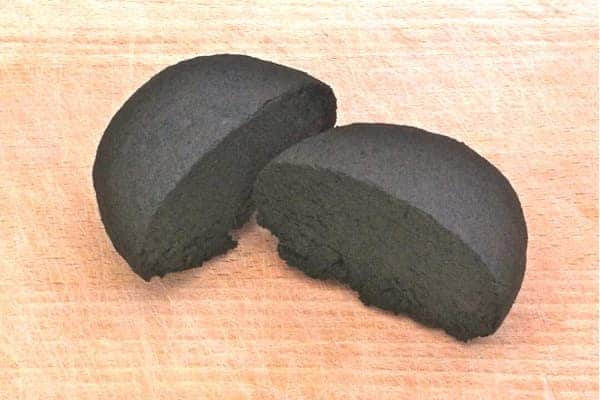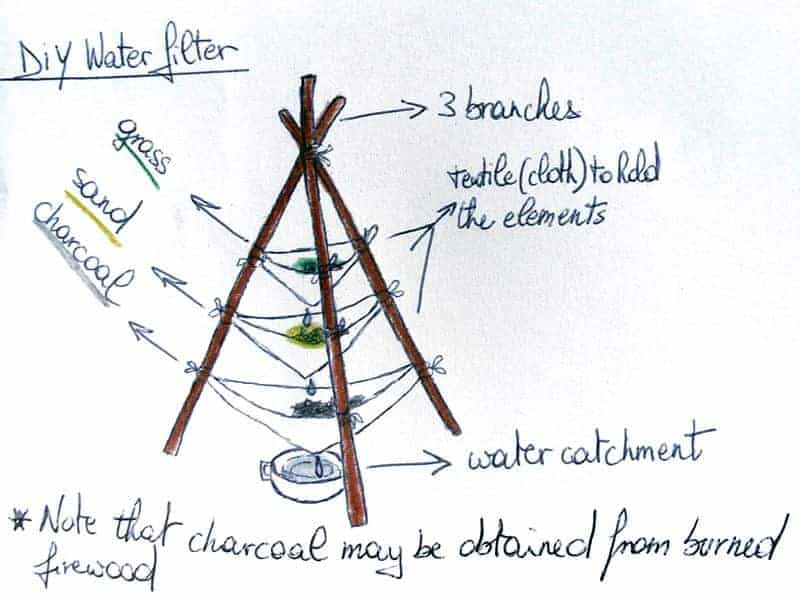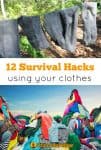For many people, preparing for disaster means stockpiling lots of supplies and gear. While this is undoubtedly important, true survivalists know that you can’t always rely on stockpiles to keep you alive.
Gear gets stolen, supplies get destroyed by the elements, or other unknown factors come into play.
Thus, the best way to survive is to use what you have.
I’ve talked about this before in posts about
Those of us who can think outside of the box and come up with creative solutions will be able to adapt to the circumstances and survive.
If SHTF, there will likely be a lot of random clothes strewn all over the place. There are lots of survival uses for clothes.
Don’t just look at these specific uses, though. Let these examples show you just how much you can do with everyday objects and get your survival creativity going.
1. Tie a Splint
If a bone gets broken, the first thing you need to do is immobilize it. The same goes for any limb with a snake bite. Grab a sturdy stick and use shreds of clothing to tie the splint in place.
2. Bra Dust Mask
A dust mask is one of the most critical yet most-forgotten Bug Out Bag items.
Hopefully, you’ve packed a face mask in your emergency supplies. If you find yourself in chaos without one, a bra will provide some protection. The great thing is that almost all women wear bras, and the bra has one mask for them plus an extra for a male friend.
*If you aren’t sure about masks, read this Guide to Emergency Face Masks and N95 Face Masks.
3. Make Leaf Curd
Did you know that you can eat a lot of leaves? The trick is to break them down first and extract the proteins.
In a wilderness survival situation, that would involve using a big rock to bang on the leaves. Then you’d mix them with water and filter them through a fine mesh cloth. A t-shirt or a sock will suffice!

4. Sock Gaiters
The first time I went orienteering (one of the best fun ways to learn survival skills), I was surprised at how many people wore gaiters.
For those who don’t know, gaiters look like soccer shin guards – just not as heavy.
After running through the woods, I found out why they were all wearing gaiters. I had to spend 2 hours pulling thorns out of my legs! I’m lucky I didn’t go through poison ivy or nettle patches.
You can easily make gaiters using old socks.
Just gut the toes off the socks so you can pull them over your entire shins. Then fold some newspaper or cardboard into the socks to protect your shins from cuts.
5. Pre-Filter Water
One of the essential survival skills to know is how to purify water. The last thing you want is to die from diarrhea-related dehydration because you got Giardia or some other terrible parasite or bacteria.
The good news is that you can easily purify water by boiling it for 1 minute*. The bad news is that boiling won’t remove any dirt, algae, or other gunk often in backcountry water.
The solution? Just pour the water through your shirt or bandana to pre-filter it.
*Boiling won’t purify all threats in water. Read this guide on which water treatment method to choose.

6. Tourniquet
Your clothes are great for first-aid situations when you need to tie a tourniquet.
Snake bites? NO.
Venous bleeding. Also NO.
Arterial bleeding, which can’t be controlled by direct pressure? YES.
Amputated limbs? YES.
If you aren’t sure about how or when to use a tourniquet, read this guide to Using a Tourniquet. Or this guide to choosing the best tourniquet for your pack.
7. Sharpen a Knife with a Leather Belt
A knife is the ultimate survival tool, but a dull knife is almost useless and could be dangerous.
In a survival situation, you can sharpen a knife with alternative methods – such as a piece of glass or rock. Don’t expect to get a smooth, razor-sharp edge with those methods, though! That is where your leather belt comes in.
Leather belts can be used for stropping, a process that removes the microscopic burs on the edge of a knife or blade.
Learn more survival uses for a belt here.
8. Lashings
Every good survival kit should contain cordage. You might even want to carry some extra cordage on you with your Everyday Carry – such as by making paracord projects like keychains and bracelets.
If you find yourself without any cordage, tearing your clothes into strips should work for basic needs like lashings for a short-term shelter.
It sure beats making cordage out of plant fibers anyway!
9. Self Defense
Ever watched a prison drama movie? Then you’ve undoubtedly seen one of those soap-beating scenes.
It might not beat a firearm or a knife, but a hard object swung in a sock is better for self-defense than nothing.
See more non-lethal self-defense weapons.
10. Filter Coffee
Just because the End of the World has come doesn’t mean you can’t enjoy coffee. Actually, you’ll probably enjoy the small luxury even more.
But how are you going to make coffee?
One solution is to put your coffee grounds into a (clean) sock or piece of clothing and pour boiling water through it.
11. Bandage
I am more worried about first aid than the average prepper (at least the ones in my circle). My home first aid kit is well-stocked, and I’ve got a miniaturized first aid kit for my Bug Out Bag.
Of course, these kits contain many types of bandages.
Other than for stopping bleeding, you should never use your clothes to dress an open wound. They are dirty and will result in infection!
However, if you don’t have sterile dressings, you can boil strips of clothing and use them as bandages.
Remember to change the dressings regularly, boiling them each time.
12. Make Medicinal Oils
I recommend you get a medicinal plant book (Amazon link) for your area and start reading. Knowing which plants are healing could go a long way toward your survival!
You should also consider planting a medicinal survival garden.
Once you have medicinal plants, you must extract the compounds from them. That usually involves soaking them in an oil or alcohol and squeezing them through a fine mesh cloth.
That’s where your clothes come in – use the clothing to strain your medicinal oils.
What other survival uses for clothes can you think of?




In summer or other times we see hikers wearing as a top only a short sleeved T-shirt. They usually end up with multiple scratches and various scrapes and abrasions after passing through bush etc.
In scouting we would always recommend our scouts and leaders wear both the T-Shirt followed by a good long sleeved normal shirt (with pockets) If the trail was smooth then wear just the T/shirt and tie the L/S shirt around your waist , if country and bush rough slip on the L/S shirt.
As an added feature the T/Shirt can serve so many other uses as needed. It is especially useful as substitute bandages, cordage or filters etc. We always said carry one or two more in your pack especially in summer. They limit a lot of sun burn also on sunny days
in the Navy, they taught us how to use a clothes for flotation you have to keep them wet
A t-shirt makes a decent head cover. Use the neckline to look through and tie the sleeves behind your head.
A long-sleeve shirt with the cuff safety-pinned to the opposite shoulder can act as a sling for a wounded arm, without destroying the shirt.
Jeans backback
Very good article. I’m gonna look into that leaf curd!